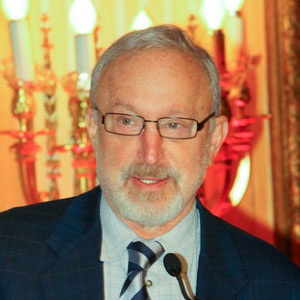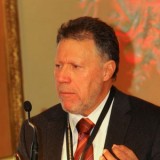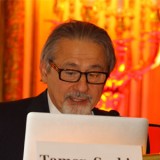Endometriosis Foundation of America 2014
My history with endometriosis surgery: four decades of life in and outside of the operating room
- Harry Reich
It is a great pleasure to be here. I thank Padma and Tamer for starting this foundation. As you can see Tamer is in good company there, this was I think in Belgium many years ago. But I met Tamer jogging in Maui. That was back, I think, in 1990/91. He was very interested in laparoscopic hysterectomy and the type of surgery that we were doing.
My topic is "My History in the Development of Advanced Endometriosis Surgery". I will say it from the outset that I am not a big fan of retrograde menstruation. I am much more - I think you really have the cells for the potential of endometriosis before you are born. That is why I believe that excision works best because you can excise it and help the patient.
I would like to emphasize that I am not famous anymore but I once was. In 1988 I slipped behind the peritoneum without anyone's permission, found and coagulated the uterine arteries and carried out the very first total laparoscopic hysterectomy. But I am more famous in the United States for this slide because it was on Ob.Gyn.News and showed me operating without a mask, which we did for at least 20 years. Realize that laparoscopy before 1986 the surgeon's head was in the O/R field because we used a scope. We had to look through a scope not using video. Video has been a great advance for us. But we still had really an infection free result from this type of surgery.
Let us quickly say how the field evolved and I am going to go pretty fast because I would like to talk about the history of abdominal surgery and state that John Hunter became very renowned both as a grave digger in early London days and as a dissector of all these specimens that he was able to bring up in the night. He only believed what he did, what he saw from his own eyes and his own work. This was before anesthesia. It was not until the 19th century, the early 1800s that we had anesthesia and could do regular surgery. I felt like John Hunter, I preferred to see evidence with my own eyes rather than the written work of others.
When I started practice my main interest in 1976 was vaginal surgery and laparoscopic surgery. I was unfortunately in the days where the big surgeon was the one who made the biggest incision. Unfortunately, our insurance companies still think that.
Thomas Cullen is pretty much given the name of the man who first talked about endometriosis and felt that operating on endometriosis was much harder than cancer surgery.
My teacher was Robert Kistner. Bob Kurman knows well; remember the Kistner days, Boston Hospital for Women. Kistner did an operation just like I described there. Diagnostic laparoscopy, you bring them back two months later for pfannensteil laparotomy, uterine suspension, endometrioma incision and presacral neurectomy. I say where is the cul-de-sac? It still was not discovered because they did a presacral neurectomy! You could have all kinds of disease. I think Dr. Franklin in Houston was doing some more work.
In 1976 I started practice and got interested in laparoscopy. I am from a small town in Scranton-Wilkes-Barre, Pennsylvania. I was born there, I still live there. Expertise was hard to obtain in my part of the world. Most Ob/Gyn, in fact all Ob/Gyn Chairmen had very little interest in endoscopic surgery and laparoscopy. Realize, until 1986 it was confined to the operating surgeon because it was very hard to see what was going on for the other people in the room.
For me, well, huh, we had Victor, Victor is here in the room but we had three giants that I had heard about in 1976 to 1980. Those were Victor Gomel, who is certainly the man who was a pioneer in microsurgery and did some early laparoscopic work, Kurt Semm and Maurice Bruhat. I do want to mention these people in this talk quickly because you will hear a lot about Kurt Semm soon because Lilo Mettler worked with Kurt, I will be talking about her later. She worked with Kurt for many years as did we all. Kurt told me in 1986 he said, "You must learn to suture and you'll be king". I do not know if I ever got to be king like he was.
Bruhat I will talk about in a little while. But Bruhat is well known because he developed the team around him and some of the best laparoscopic surgeons in the world trained in Clermont-Ferrand in the center of France. I will talk about him in a moment. But the first time I ever saw endometrioma excision was with Bruhat's team.
I started in 1976 and I was very interested in certain operations. When I say I did an oophorectomy by laparoscopy that was in the days of tubal ligation. If you did an oophorectomy - that meant bleeding that you could not control during tubal ligation. I realized that with bipolar we could do almost any surgery in a woman. By 1977, I had an interest ever since my residency, in the treatment of abscess and infection. I always felt it was wrong that acute adhesions were much easier to divide than chronic or vascularized ones. That is an area that really has been swept under the table. We hear very little about that today. In 1983 I felt my learning curve was over. I decided to do no more laparotomies and over the next 20 years I did ten laparotomies, I think. We were able to do almost everything by laparoscopy.
The state of the art probably in the United States around 1980 operative laparoscopy was practiced in Keil, West Germany with Kurt Semm, it was in Clermont-Ferrand and Paris from Palmer and his team in Paris, and Vancouver. I forgot! Well, this slide was made before I knew you Victor. This slide was made, you can see it was made in 1985, a long time ago. But anyway, 1984 seriously, the AAGL rejected the concept of operative laparoscopy. In 1985 all of a sudden it was accepted. For myself, this is sort of important because I spoke at the AAGL clinical meeting. Bob Kurman who is here, helped me review this slide a day or two before because I was nervous and I was shot down so badly about this that I needed something for an ego boost. I went to France and I was over in France for a couple of weeks and during that time I spent two days with Professor Bruhat. In that two days he gave me the stimulus to be able to present more with laparoscopic surgery because I saw a team of five different individuals all in a department who were working together for the promotion of laparoscopic surgery.
I mention this because Professor Bruhat died last week. It is sad for the whole community. I know Tamer and I talked about it, I think we had something on the Foundation website about it, which I want to write more about the personal tragedy for me. I was with him in November at a meeting.
In 1985, a few months later, I had the courage to come up and give a talk at the AAGL, our American laparoscopy society which was really a tubal ligation society back then. They did not do much laparoscopic surgery. To tell you the truth, that was the first year that they were doing laparoscopic surgery. As you can see the program up there Kurt Semm gave the first talk and I had two talks and Camran had a talk and I introduced the concept of bipolar oophorectomy and the concept of excising endometriomas. Now we were excising pretty large endometriomas back in 1985 because I always had this feeling that if you excised the patients did much better than if you burned or you lasered or you did whatever. We were excising. We had a large series back then and we were able to get it published. I mention that as it will become obvious in a second. But we were able to get our 79 cases but still I did not have the pregnancy results that I wanted or the pain relief results that I wanted and we started looking more and more into the cul-de-sac and what we could there.
For me, personally, 1985 I gave a talk at the AAGL and in 1986 I was part of an advanced course in laparoscopic surgery along with on the other side they had the German course and I said, "This isn't right". The following year they had the French course and then the year after that they had an American course. Laparoscopic surgery in 1988 was divided into three different fields. The German course, the French course and the American course and that continued for quite a while, we all get along today.
We had very little to go on with endometriosis back then. If you look at the slide there at the bottom you will 82 percent of patients were lost to follow up with laparotomy excision of endometriosis surgery. I looked at our stuff and I start presenting these papers in 1988 at the American Fertility Society and what I reported was a 100 cases of cul-de-sac obliteration, 67 percent - 20 out of 30 - had a second laparoscopy and had disease, it says persistent disease because it is not recurrent it is disease I probably did not get the first time. But again 33 percent had no disease and with multiple biopsies. By multiple biopsies I use to run the alphabet. I would go right from A to Z, sometimes with over 26 specimens.
We designed our own classification, this is back in 1987, 1988. As you can see we are doing pretty thorough excision work in these cases. We were able to, by laparoscopy, usually with scissors and a little bit of electro surgery, anyway we could not get it published. That is the story of endometriosis surgery. Very hard to get it published as you can see. Despite the extensive noteworthy experience most people felt that the direct laparotomy approach was the only way. But the direct laparotomy approach was pretty minimal - it did not do anything other than a presacral neurectomy. They just said it was unconventional laparoscopic surgery performed by an unconventional laparoscopist.
We finally got it published but then I started looking more and more why do these people recur? If you look at this picture there on the rectum that is in the bottom of the screen you see some white little areas there. Well the answer was we were not going far enough with the rectal resections. That was our future. We debated. This was a debate I had at the Second World Congress on Endometriosis, with Robert Franklin, where we argued that we could do this stuff by laparoscopy. Again, finally after many years I did get this thing published.
But this is the way that we looked at laparoscopic surgery. We had to look with our eyes. This is sort of the way we operated. I do not have very much time but I am going to go quickly. We started off with cutting current electro surgery. Never use coagulating current. We use just cutting current electro surgery and usually using the suction irrigator we were able usually to get the rectum off the posterior vagina down to loose areolar tissue or the rectovaginal septum, as you can see in there. Within a couple of years we tried laser with that and as you can see, even with extensive cul-de-sac lesions this lady had a second look. She still had rectal disease. But you can see the cul-de-sac adhesions if you excise the disease, I noticed early, the disease did not come back. This was one of the first recto-resections. This was back in 1988 where laparoscopically we resected the rectum. I saw the patient at a sushi restaurant three months ago and she has not had another procedure and has done fine ever since that operation. So excision worked well. I use scissors. I use a lot of fluid. My solution to pollution is dilution people like to say and it works. We learned how to suture with any size needle through a small little incision.
Quickly, I want to stay right on time. Probably in the early 1990s we started to realize we could with a stapler through the anus we could resect endometriosis lesions very easily as you can see and stop all the bleeding at the end of the operation and check the pathology.
Conclusion; well medical treatment never works. In my experience it has never worked. I do not know of a single endometriosis lesion that has ever been cured by any maneuverability of your hormonal status. Pelvic reconstruction by laparotomy or laparoscopy, I do not understand laparotomy and the other thing I detest today is the concept of the supracervical hysterectomy in women with endometriosis because you do not get the endometriosis. In fact, the disease oftentimes will get worse if you leave the endometriosis behind.
Now I say that just because when I was at Columbia my Columbia experience we looked at 20 months of surgical procedures of patients with endometriosis and their discharge diagnosis - 76 had abdominal hysterectomies and 20 of these had a supracervical hysterectomy with bilateral salpingo-oophorectomy. In other words, with this mistaken concept that castration and removing a normal uterus and leaving the disease behind could have an effect. The only laparoscopic cases were unfortunately done by me.
General surgery - we have seen a revolution. Since the gallbladder general surgeons will, and myself, we could actually go into the chest and remove that...endometriosis gynecology. It has been a slow evolution, it has occurred over many years and hopefully we will get it moving with Tamer's association in the right direction.
Thank you very much for your attention. I almost stayed on time and I do want to, if I get a chance, Bob Kurman and I, our next speaker, we were residents together many, many years ago. In fact we shared night call together. We had great times and we are very good friends. I have seen him a few times since but he has done so much, I think, in the field with the investigation of HPV. And now with some of his theories about pathology of endometriosis throughout the peritoneum cavity, well, I am interested in hearing what he has to say. I think this should be a great talk. For some of you who may not know, Bob is the professor of Gynecology and Pathology, I think, at Johns Hopkins University. He is the editor of the Blaustein's textbook on Gynecological Pathology. You did the best Bob. Good to hear you.










